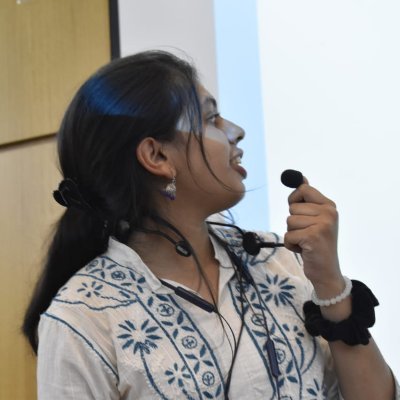
Tejal Khade
@TechCode31
Deep Learning Intern at Intel👨💻 | Painting🎨 | Music🎙️| Reading 📚|Wanderlust✈️ Grounded by Consistency.
Hi folks 👋 ✍️Just dropped a new blog on Generative Adversarial Networks (GANs)! Do read and like if you find it useful and interesting!🙌 tejalrk2000.medium.com/from-noise-to-… #GenerativeAI #machinelearning #AI
In the past few months, I have been actively exploring core concepts behind LLMs - from the basics all the way to decoder-only transformers. 🧠Key concepts behind LLMs 🔐Decoder only architectures 👉Read part 1 of blog series here : tejalrk2000.medium.com/prompt-to-pred… #LLM #transformers #AI
🚀Day31/80 of #gfg160 challenge completed. ✅ Kth missing positive number in sorted array In a sorted array, finding the first index where arr[i] > (k+i) can be optimized. Binary search is preferred to better locate i. Thus kth missing element is k+i. TC: O(logn), SC O(1) #cpp
![TechCode31's tweet image. 🚀Day31/80 of #gfg160 challenge completed.
✅ Kth missing positive number in sorted array
In a sorted array, finding the first index where arr[i] > (k+i) can be optimized. Binary search is preferred to better locate i. Thus kth missing element is k+i.
TC: O(logn), SC O(1) #cpp](https://pbs.twimg.com/media/GiOYtgGWMAAMAH2.jpg)
🚀Day30/80 of #gfg160 challenge completed. ✅ Allocate Minimum Pages Using binary search approach to minimize page limit. In simple terms, assign books to students until the limit is hit then move to the next student. TC: O(n*log(Sum(arr)- MAX)) SC: O(1) #cpp #geekstreak2025

🚀Day29/80 of #gfg160 challenge completed. ✅ Kth element of two Arrays : Here, I consider two sets for using binary search. We find a point in both arrays so that all elements in first set are smaller than all elements in other. So there is need to check the partitions. #cpp

🚀Day28/80 of #gfg160 challenge completed. ✅ Peak Element: Used a binary search approach with time complexity O(logn) and space complexity O(1). This is the optimized method to retrieve a peak element. #geekstreak2025 #CodingChallenge #cpp

🚀Day27/80 of #gfg160 challenge completed. ✅ Search in rotated sorted Array Used Binary search approach with O(logn) time and O(1) space complexity. #cpp #geekstreak2025 #CodingChallenge

🚀Day26/80 of #gfg160 challenge completed. ✅ Sorted and Rotated minimum: Attempted to solve this problem in O(logn) time and O(1) space complexity. #cpp #geekstreak2025 #gfg160

🚀Day25/80 of #gfg160 challenge completed. ✅ Number of Occurrences: Approach used : Binary search TC: O(logn) SC: O(1) #geekstreak2025 #gfg160 #CodingChallenge #cpp

🚀Day24/80 of #gfg160 challenge completed. ✅ Merge Without Extra Space: Attempted to solve this problem using the Gap sort method. TC: O(m+n)*O(log(m+n)) SC: O(1) #geekforgeeks #geekstreak2025 #cpp

🚀 Day23/80 of #gfg160 challenge completed. ✅ Non-Overlapping Intervals : Attempted to solve this problem using a greedy approach. TC: O(nlogn) SC: O(1) #geekstreak2025 #codingchallenge #cpp

🚀Day 22/80 of #gfg160 challenge completed. ✅ Insert Interval: Sorting and Interval merging approach is used here. Time complexity is O(nlogn) and space complexity is O(n). Where n is the number of intervals. #geekstreak2025 #codingchallenge #cpp

🚀 Day21/80 of #gfg160 challenge completed. ✅ Overlapping Intervals: Solved the problem in O(nlogn) time and O(n) space complexity. #geekstreak2025 #gfg160 #cpp #codingchallenge

🚀 Day20/80 of #gfg160 challenge completed. ✅ Count Inversions: I used Merge sort step to count the Inversions in this problem giving O(nlogn) time and O(n) space complexity. #cpp #CodingChallenge #geekstreak2025

🚀 Day19/20 of #gfg160 challenge completed. ✅ Sort 0's, 1's and 2's : Attempted to solve this problem using O(n) time and O(1) space complexity. #CodingChallenge #geekforgeeks #cpp

🚀Day18/80 of #gfg160 challenge completed. ✅ Min Chars to Add for Palindrome: Attempted the problem using the KMP algorithm in O(n) time and O(n) space complexity. The min no. of chars to make the string palindrome is the length of the input string minus last entry of lps array.

🚀 Day17/80 of #gfg160 challenge completed. ✅ First Non repeating Char: Attempted the problem by storing indices in a single traversal. TC: O(n) where n is length of input string s. SC :O(MAX_CHAR) where MAX_CHAR=26 as the input string has only lowercase alphabets. #cpp #gfg160

🚀 Day16/80 of #gfg160 challenge completed. ✅ Anagram: Initialize frequency array of size 26 and use chars as index in this array. Traverse s1, increment the value in array. Traverse s2 and decrement value. As value at every index is 0, the frequency of each char is same. #cpp

🚀 Day15/80 of #gfg160 challenge completed. ✅ Add Binary Strings: We first trim leading zeros and then start from the last character of the strings and compute digit sum. If sum>1 then store carry for next digits. For extra carry prepend 1 of the result. TC:O(n+m) SC: O(1)

🚀 Day14/80 of #gfg160 challenge completed. ✅ Implement atoi: I attempted this using a naive approach to use a data type which has a size greater than 32 bits. Also we simply compare with (2^31 - 1)/10 and avoid comparison with -2^31/10 while making our the absolute value.

United States Trends
- 1. Steelers 53.3K posts
- 2. #ITZY_TUNNELVISION 25.1K posts
- 3. Rodgers 21.5K posts
- 4. Mr. 4 4,811 posts
- 5. Chargers 38.4K posts
- 6. Resign 113K posts
- 7. Schumer 233K posts
- 8. Tomlin 8,411 posts
- 9. Tim Kaine 22.2K posts
- 10. 8 Democrats 10.2K posts
- 11. Rudy Giuliani 12.2K posts
- 12. Sonix 1,371 posts
- 13. Dick Durbin 14.4K posts
- 14. Voltaire 8,550 posts
- 15. #BoltUp 3,119 posts
- 16. 8 Dems 7,851 posts
- 17. Angus King 18.4K posts
- 18. #ITWelcomeToDerry 5,022 posts
- 19. Keenan Allen 5,126 posts
- 20. #RHOP 7,211 posts
Something went wrong.
Something went wrong.










































































